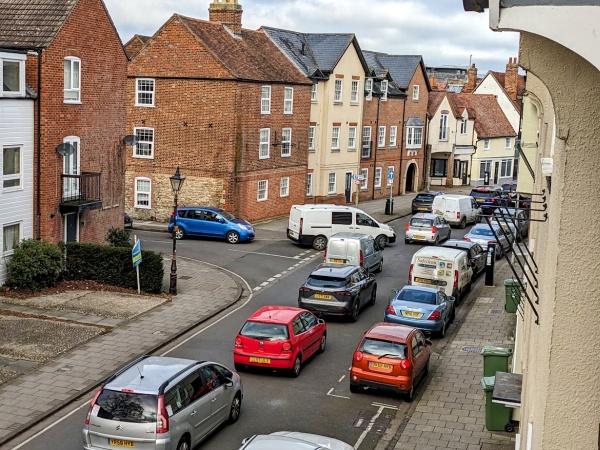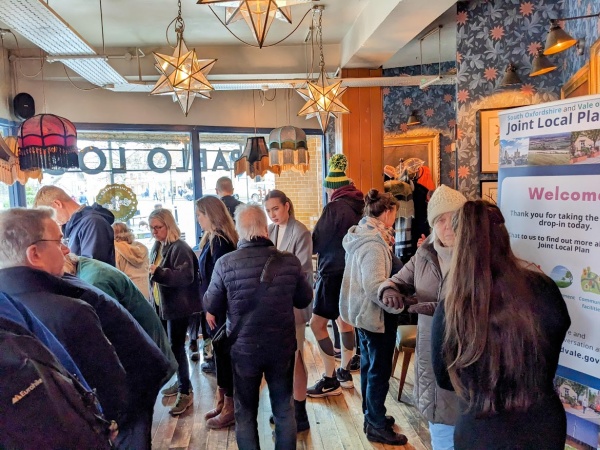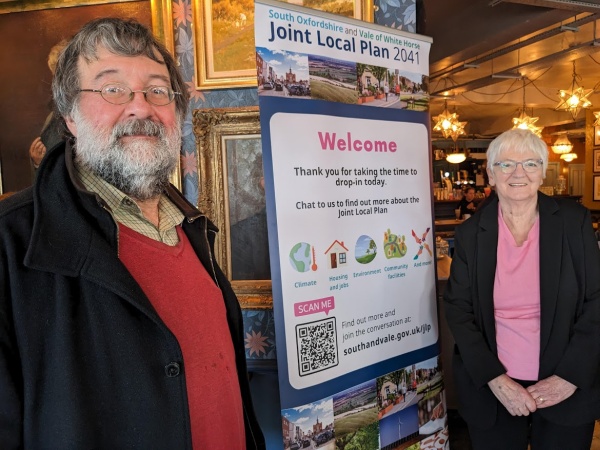The consultation in Abingdon to discuss the new local plan up to 2041 mirrored the traffic in Abingdon this morning.

* Traffic up West St Helen Street.

* Consultation in a corner of Pablos Lounge.
The venue became as much a talking point as the plan in the morning. The crush had eased off by afternoon, as had the traffic.

It was good to see Roger and Bobby, who attend most of Abingdon’s consultations, as experts and friends of Abingdon. Hopefully, the location at Pablos also attracted more people who wouldn’t typically attend such consultations.
Janet M said building more homes in Dalton Barracks and Culham, as proposed in the 2041 plan, would worsen Abingdon’s traffic. She agrees new homes are needed but wants better road infrastructure and bike paths first to manage the extra traffic and encourage cycling.
Mike thought it was crunch time for Culham, and said now was the time to stop more houses at Culham, and help save Abingdon, through this local plan.
The plan proposals can be viewed and commented online at https://jlp.southandvale.gov.uk/.
The traffic has been particularly bad in West Saint Helen Street. It seems to be connected to the 20 mph limit. It was not so bad before. Cars do not move on the High Street to let cars out as they are stuck too. On Friday Feb 2nd there was the usual jam in the morning at rush hour which took a while to clear. The jam returned at 1.30 pm and carried on until 4.30pm. There was a short break and it continued until after the rush hour. Fumes in the air are certainly there for longer now. Weekday mornings and afternoons are much worse than they used to be.
I have lived in West Saint Helen Street since 1981 and things have definitely changed!
Hmm, not sure it’s to do with 20mph, quite a few people do like to look for parking in WSH Street -which is often full because it’s a nice handy car park – then they get stuck in traffic. (while it’s nice to see the electric vehicle charging points in that car park they have reduced the number of bays available for petrol cars, not sure it’s enough to affect things but -8 or 10 spaces, perhaps it does a little bit.) The fact that the multi-storey car park at the Charter is no longer viable with several levels totally out of action definitely adds to a shortage of quick and convenient parking for the town centre.
If Drayton Road is queued up to the mini magic roundabouts (which is often, especially on weekends) then cars nip down Caldecott, past the Wharf and into WSH Street too and get stuck in the queue as well. I think the town centre queues could be eased by another bridge near Drayton road, but really, that’ idea has been pitched and thrown out a hundred times. The multi storey car park needs to also be addressed, but that’s probably a funding issue, it would cost a lot to do something with in this current financial climate.
I can remember Abingdon town centre being like Brands Hatch in the 80’s and 90’s, the one-way system had people bombing through it two-abreast, and yes, while I do drive, I don’t think that was a good thing for an old market town. Can’t count how many times the Abivale Vets lost their stone wall due to cars crashing into it at speed.
Unfortunately it is not possible to say that the 20mph limits are having any negative affects; in the same way it is impossible to say that the 20mph limits are having any positive effects. No quantitative “before” assessment was made, and so none can be compared afterwards. One doesn’t need such robust testing when there’s cheap and easy political capital to [hope] to be gained. As such…we’re now lumbered with something else ill thought out, probably useless and all at rate-payers cost.
Meanwhile, Jaguar Land Rover, Nissan and MINI produce 600, 560 and 480 cars a day – A DAY…every….single…day…. So; let’s ignore that elephant in the room and get everyone cycling in Abingdon. That’ll fix it!
Who is Janet M referenced in the text above?
The comment is that more cycling routes/cycle friendly routes are needed. We already have cycle paths which are unused. Why perpetuate a model which doesn’t work!
the only way you’re going to reduce that traffic is by preventing people from driving, how you do that i couldn’t say…..
I think there-in lies the problem. People see a problem and then are floundering from one awful binary solution to another. The answer must be black; or the answer must be white. Wow….go us, look at the best we can do…
From this starting point it is doomed to failure.
Life is what happens in the grey. Nuance. Subtlety. Sometimes you need to wiggle a nice juicy large bit of walnut out of it’s shell, rather than use a sledgehammer and eat a mouthful of dust and shell.
Some of the words you use Rudi are also part of the problem (none of this is aimed at you personally, just using it as a straw man). “Reducing” and “preventing” people from doing anything is a very negatively loaded stick to beat society with.
I thought we are beyond punishing the behavours we hate, and are now supposed to positively reinforce the behaviours we want? Why is this traffic issue any different.
How about we stop “preventing” people from doing things they clearly want to do. Perhaps we should stop loading the notion of “reduce” with “or else”.
People clearly want to drive.
The problem is that they make poor driving choices, and it is those poor choices that can exacerbate congestion.
Allow people to drive. Encourage people to drive…but encourage them to do so “better”…Encourage beneficial driving habits.
Here’s a positively reinforceable driving habit…
Allow carshareers to use bus lanes. Allow carshareers to park for free in carparks. Allow carshareers 10% off council tax. Positively reinforce carsharing – for example, makes it worthwhile to make better driving decisions…with better driving decisions; who knows you may reduce car use by 25, 50…even 75%…
Or shall we continue to play the political fiddle, choose the easy way and continue to just punish and beat the car driver; like we beat our kids or kick our pets? It’s clearly not working, is it.